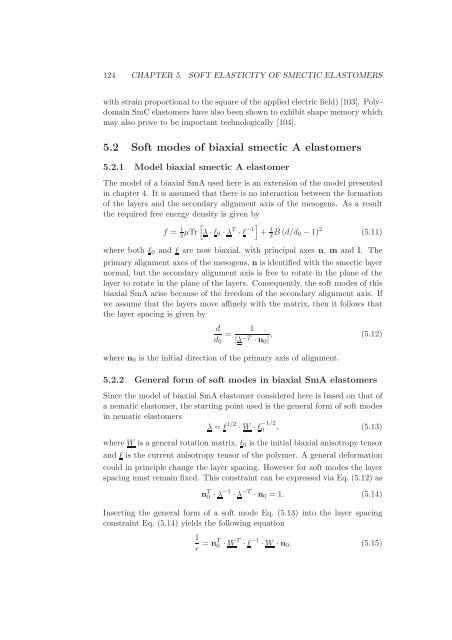Statistical models of elasticity in main chain and smectic liquid ...
Statistical models of elasticity in main chain and smectic liquid ...
Statistical models of elasticity in main chain and smectic liquid ...
Create successful ePaper yourself
Turn your PDF publications into a flip-book with our unique Google optimized e-Paper software.
124 CHAPTER 5. SOFT ELASTICITY OF SMECTIC ELASTOMERSwith stra<strong>in</strong> proportional to the square <strong>of</strong> the applied electric field) [103]. Polydoma<strong>in</strong>SmC elastomers have also been shown to exhibit shape memory whichmay also prove to be important technologically [104].5.2 S<strong>of</strong>t modes <strong>of</strong> biaxial <strong>smectic</strong> A elastomers5.2.1 Model biaxial <strong>smectic</strong> A elastomerThe model <strong>of</strong> a biaxial SmA used here is an extension <strong>of</strong> the model presented<strong>in</strong> chapter 4. It is assumed that there is no <strong>in</strong>teraction between the formation<strong>of</strong> the layers <strong>and</strong> the secondary alignment axis <strong>of</strong> the mesogens. As a resultthe required free energy density is given byf = 1 2 µTr [λ·l 0 ·λ T ·l −1] + 1 2 B(d/d 0 −1) 2 (5.11)where both l 0 <strong>and</strong> l are now biaxial, with pr<strong>in</strong>cipal axes n, m <strong>and</strong> l. Theprimary alignment axes <strong>of</strong> the mesogens, n is identified with the <strong>smectic</strong> layernormal, but the secondary alignment axis is free to rotate <strong>in</strong> the plane <strong>of</strong> thelayer to rotate <strong>in</strong> the plane <strong>of</strong> the layers. Consequently, the s<strong>of</strong>t modes <strong>of</strong> thisbiaxial SmA arise because <strong>of</strong> the freedom <strong>of</strong> the secondary alignment axis. Ifwe assume that the layers move aff<strong>in</strong>ely with the matrix, then it follows thatthe layer spac<strong>in</strong>g is given bydd 0=1|λ −T ·n 0 | , (5.12)where n 0 is the <strong>in</strong>itial direction <strong>of</strong> the primary axis <strong>of</strong> alignment.5.2.2 General form <strong>of</strong> s<strong>of</strong>t modes <strong>in</strong> biaxial SmA elastomersS<strong>in</strong>ce the model <strong>of</strong> biaxial SmA elastomer considered here is based on that <strong>of</strong>a nematic elastomer, the start<strong>in</strong>g po<strong>in</strong>t used is the general form <strong>of</strong> s<strong>of</strong>t modes<strong>in</strong> nematic elastomersλ = l 1/2 ·W ·l −1/20 , (5.13)where W is a general rotation matrix, l 0 is the <strong>in</strong>itial biaxial anisotropy tensor<strong>and</strong> l is the current anisotropy tensor <strong>of</strong> the polymer. A general deformationcould <strong>in</strong> pr<strong>in</strong>ciple change the layer spac<strong>in</strong>g. However for s<strong>of</strong>t modes the layerspac<strong>in</strong>g must rema<strong>in</strong> fixed. This constra<strong>in</strong>t can be expressed via Eq. (5.12) asn T 0 ·λ −1 ·λ −T ·n 0 = 1. (5.14)Insert<strong>in</strong>g the general form <strong>of</strong> a s<strong>of</strong>t mode Eq. (5.13) <strong>in</strong>to the layer spac<strong>in</strong>gconstra<strong>in</strong>t Eq. (5.14) yields the follow<strong>in</strong>g equation1r = nT 0 ·W T ·l −1 ·W ·n 0 . (5.15)
















